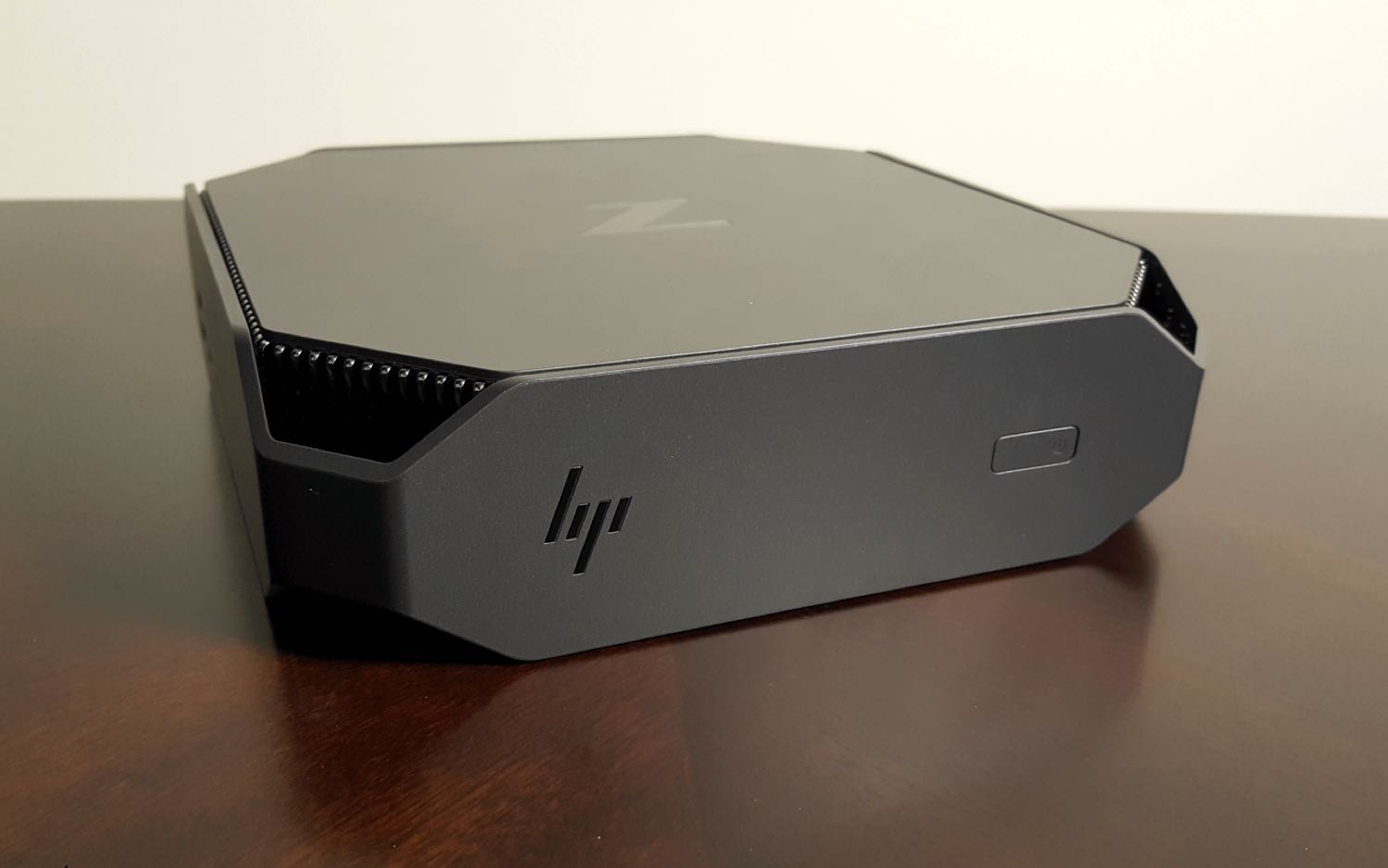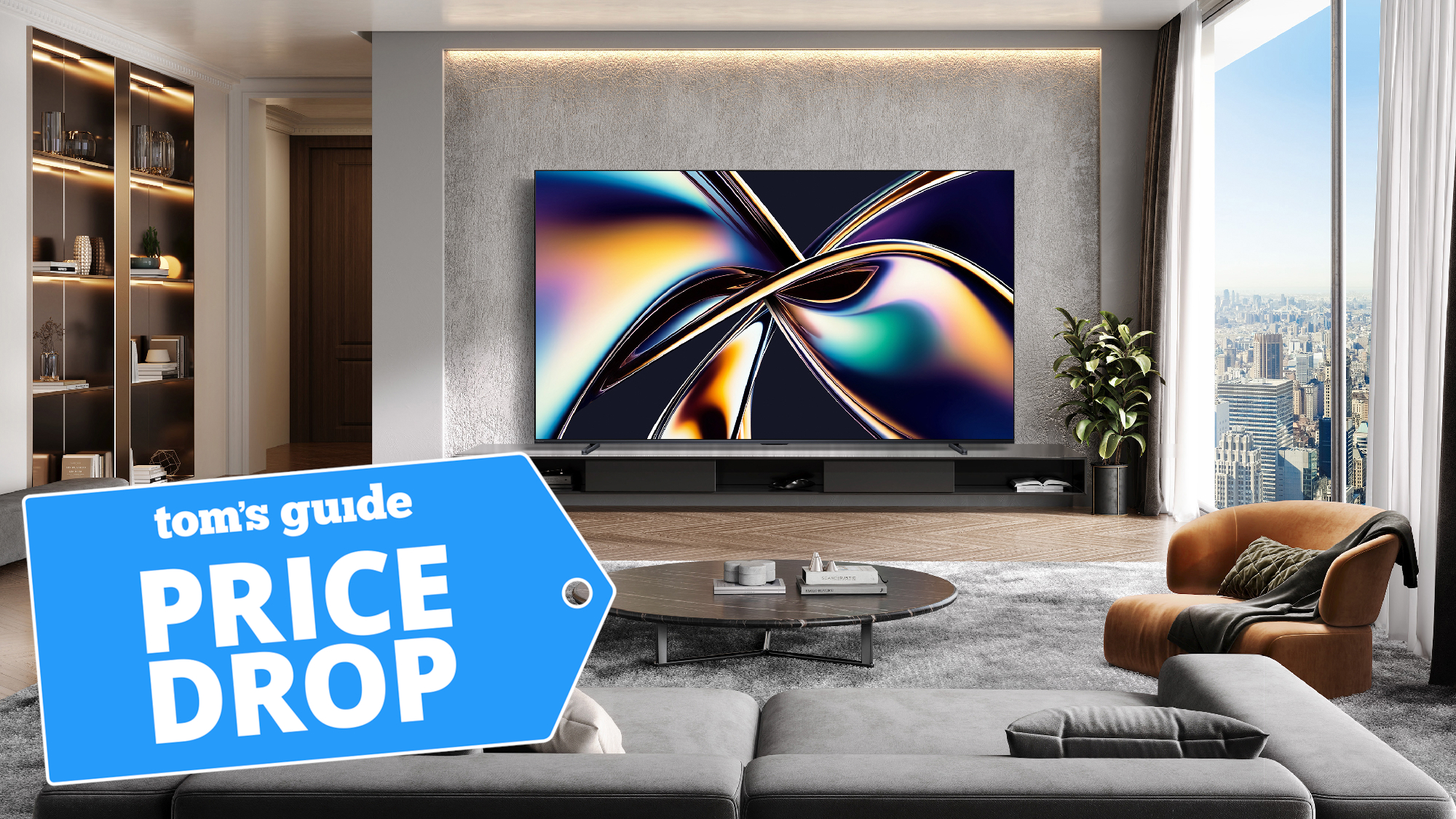Tom's Guide Verdict
The HP Z2 Mini G4 is a small wonder, packing workstation-class parts and performance into a compact chassis that can stow anywhere. It's the most powerful mini PC we've reviewed.
Pros
- +
Powerful processing and graphics hardware
- +
Internals are easy to access
- +
Category-leading performance
- +
Highly configurable components and ports
- +
Security is built in
Cons
- -
Cooling fans get loud
- -
Windows 10 Pro still includes dumb bloatware
Why you can trust Tom's Guide
The HP Z2 Mini G4 may look a bit familiar, with an exterior that is note for note the same as last year's Z2 Mini G3 workstation. But that small, unassuming design still holds plenty of surprises. Last year, I couldn't quite see a way for HP to cram more power into the compact chassis of the Z2 Mini – the 2017 model was already impressive, and ticked all the right boxes to satisfy all but the most demanding workstation users. But with new ISV-certified graphics options, an expanded selection of processors and an even more configurable port selection, the Z2 Mini G4 picks up where the G3 left off and sprints downfield with aplomb. It's the best tiny workstation we've seen and one of the best mini PCs on the market.
Design
The Z2 Mini G4 is a study in compact design. The gray plastic chassis measures just 8.5 x 8.5 x 2.3 inches, but inside is the sort of power normally reserved for larger desktop towers. That's not much larger than the Lenovo ThinkCentre M710Q Tiny (7.05 x 7.20 x 1.36 inches) or the Intel Hades Canyon NUC (8.7 x 5.6 x 1.5 inches), though the Z2 Mini G4 is the only one of the three that boasts workstation-grade hardware.
In most respects, the Z2 Mini G4 has the same external and internal design features of the 2017 model, the HP Z2 Mini G3 – the small, boxy chassis is distinguished by its corner-mounted vents, each with an additional bumper that ensures adequate space for ventilation and cooling.
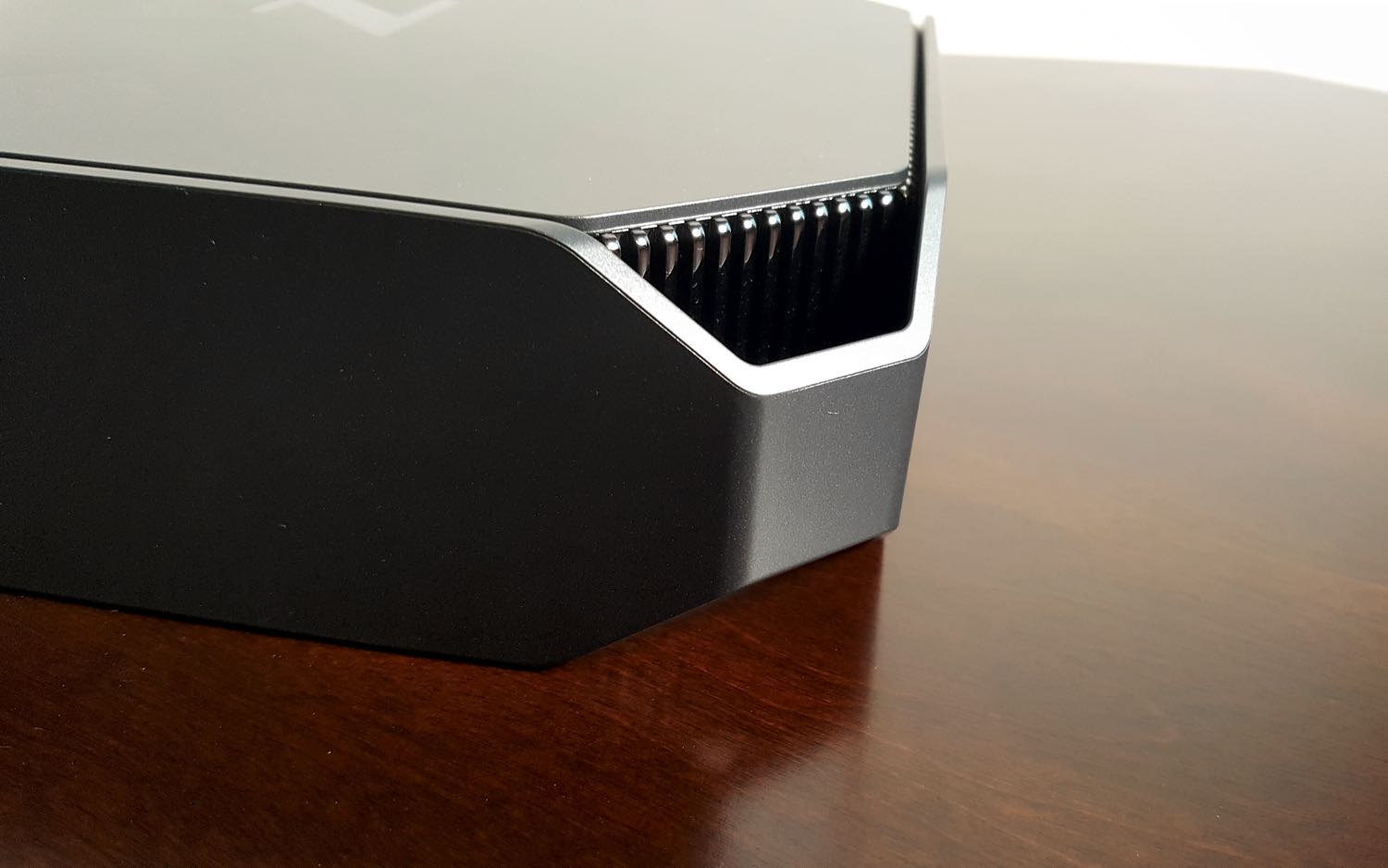
The top lid of the small chassis can be removed without tools, and the internals of the system are far more accessible than most mini PCs allow. The easily accessible design includes a hinge-mounted cooling fan that flips up out of the way to let users reach the two SO-DIMM slots, and easy-to-access screws let you remove the fan and hard drive to access the rest of the internals.
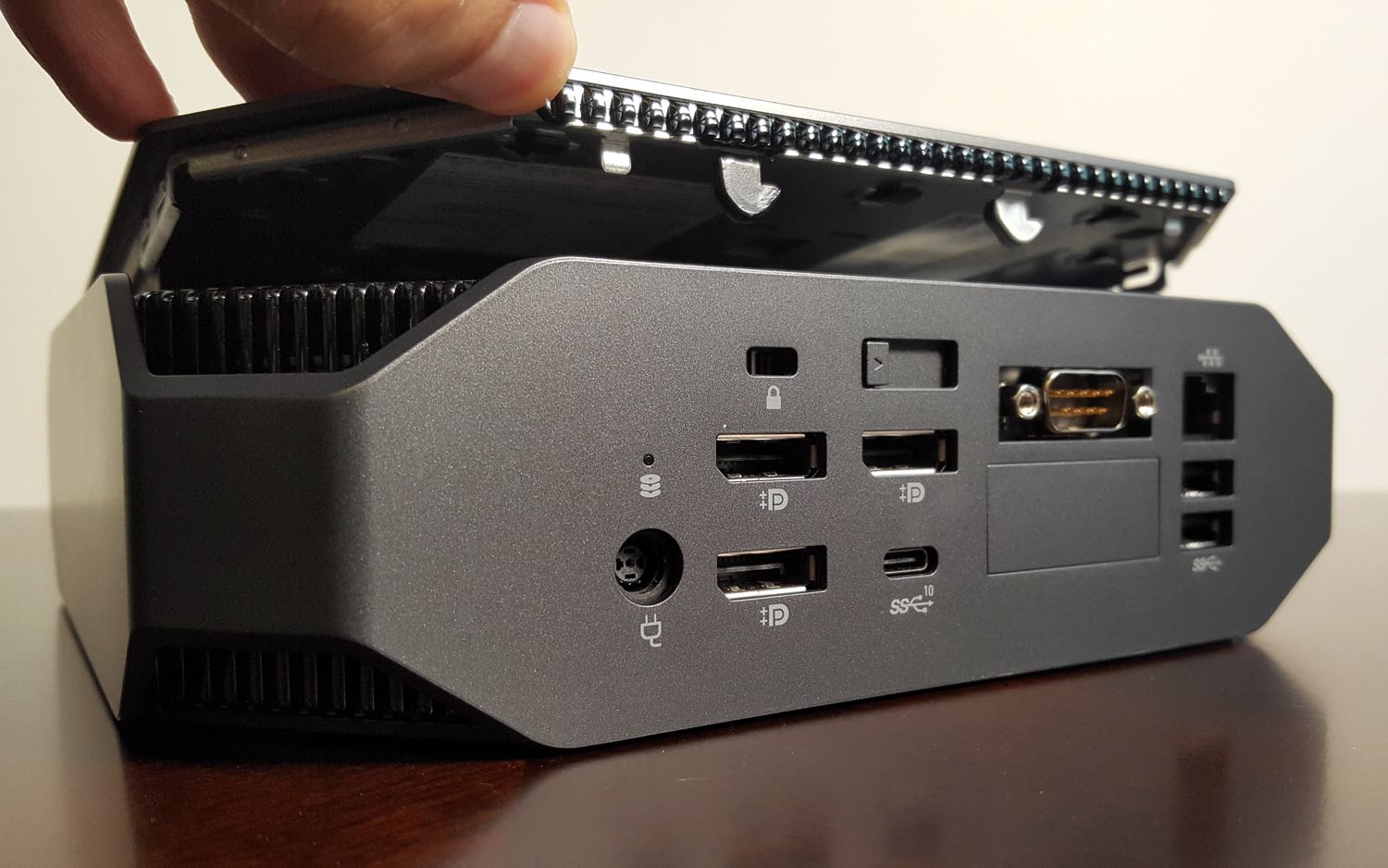
There are two key differences from the 2017 model, however. The first is weight, where the Z2 Mini G4 weighs 4.85 pounds, heavier than the 2017 model's 4.6 pounds. The other major difference has to do with the internal hardware, which offers up to a 6-core Intel Xeon processor and much more potent graphics options. In addition, there's an expanded port selection that can be configured with a wide array of connectors using what HP calls "Flex I/O."
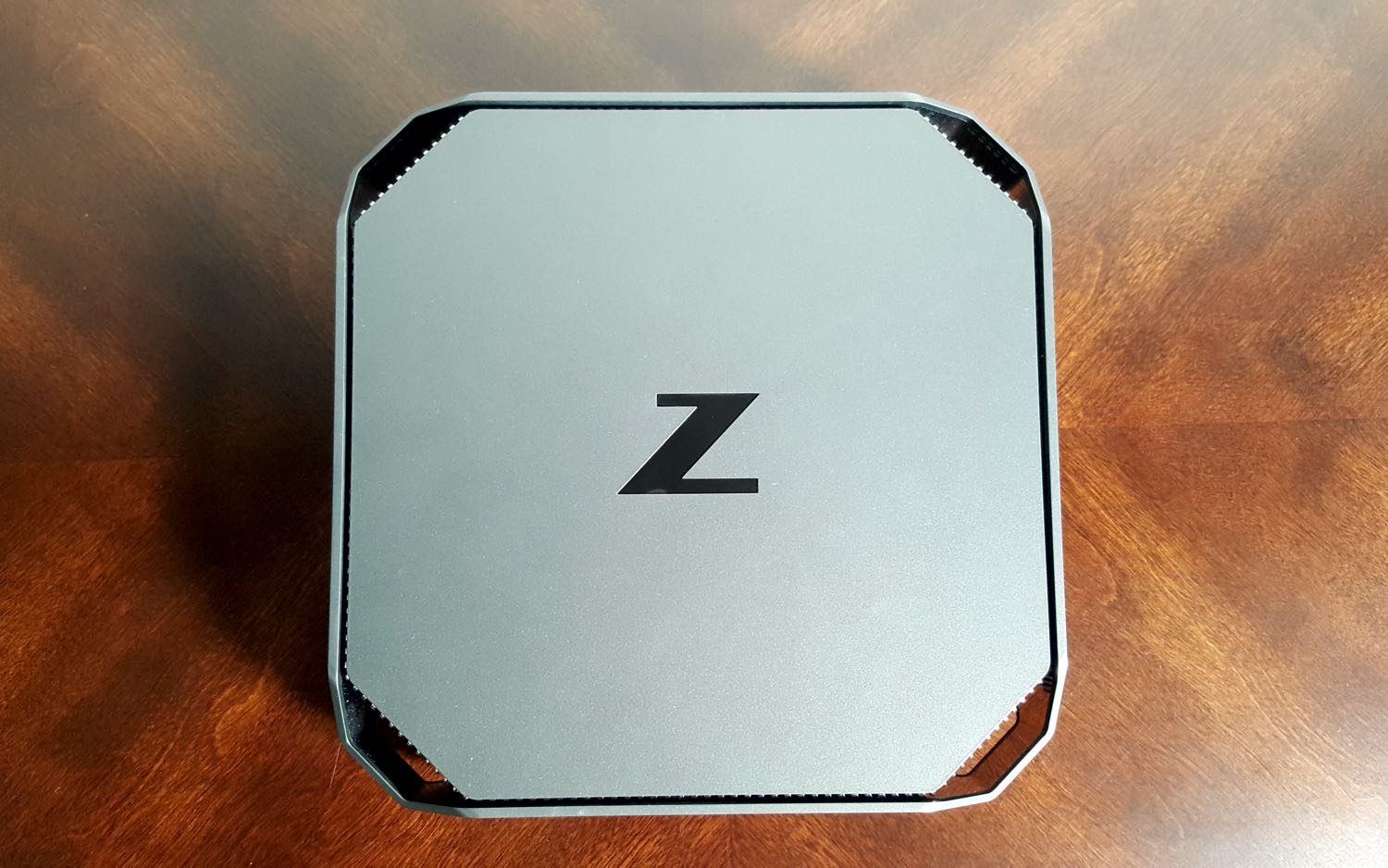
About the only inelegant part of the design is the power adapter, which uses an external brick instead of an internal adapter. That brick is one of the largest I've seen, measuring 7.8 x 3.9 x 1.0 inches, large enough that you'll need to think about where to stash it.
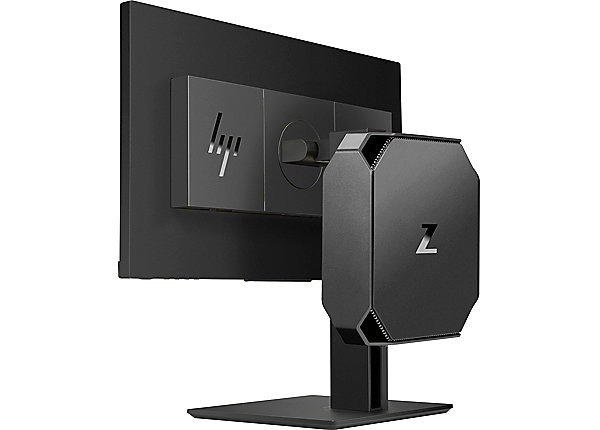
While the mini PC form factor is often touted for its ability to be mounted on the back of a monitor or tucked out of sight on a desk – all of which the Z2 Mini G4 can do – the compact system also comes with the option of rack mounting for enterprise use. The small workstation and accompanying power brick can be stored seven to a tray, with as many as eight trays in a standard 42U rack – letting businesses set up 56 systems per rack for centralized hardware.
Ports
The Z2 Mini G4 has a lot of ports, and the wide selection of connectors is enhanced by HP's customizable Flex I/O port add-ons. The side of the Z2 Mini G4 has a combined headset jack for audio, a pair of USB 3.0 ports and a 10 Gbps USB 3.1 Gen 2 Type-C port (Check out our USB Type-C FAQ to sort out which USB Type-C port is which).
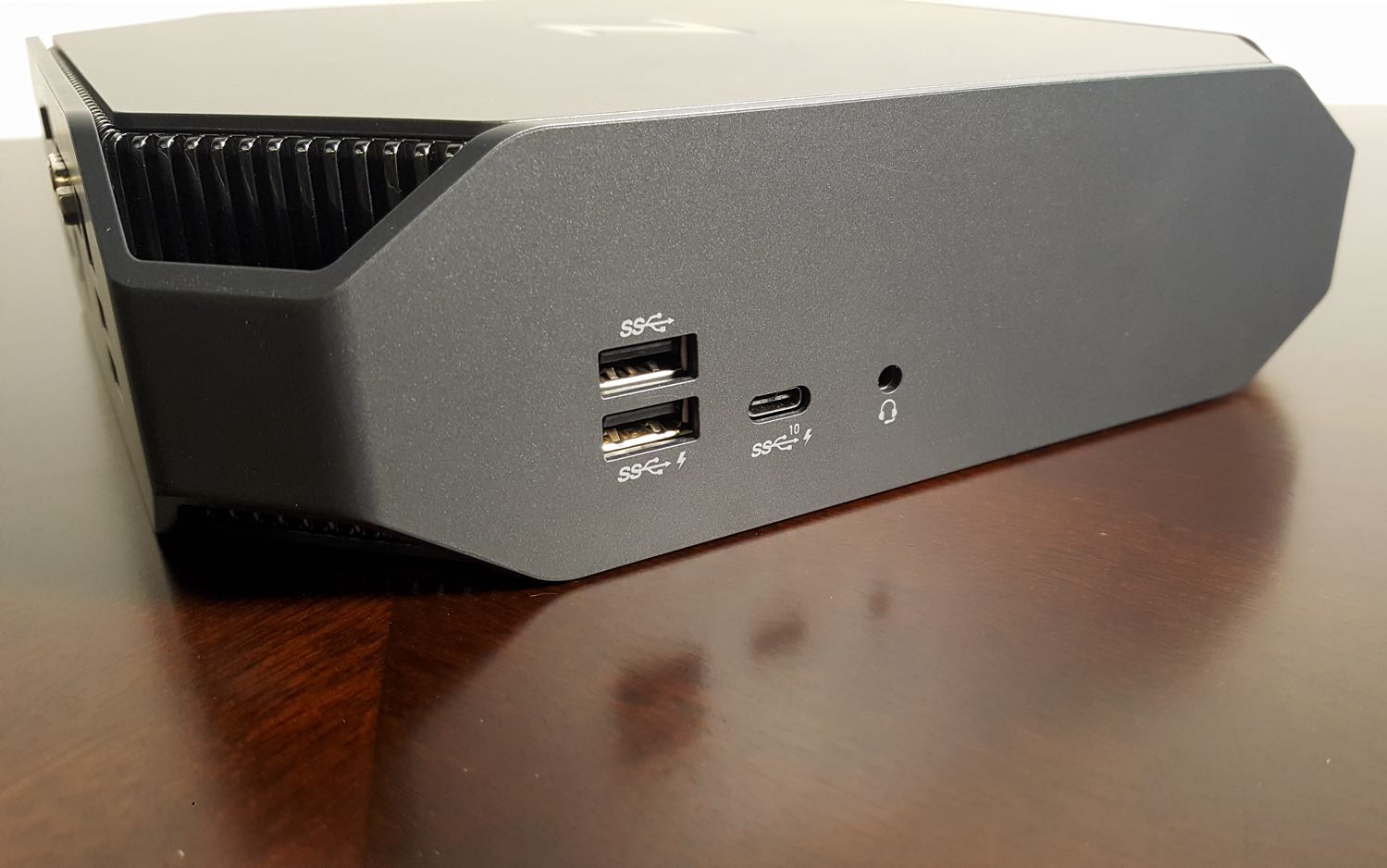
On the back of the box you'll find a second 10 Gbps USB Type-C port, as well as two USB 3.0 ports, three DisplayPort connectors and a Gigabit Ethernet port. Our review unit also came with a VGA connection, but because it's situated in one of the configurable Flex I/O slots, it isn't necessarily a standard port.
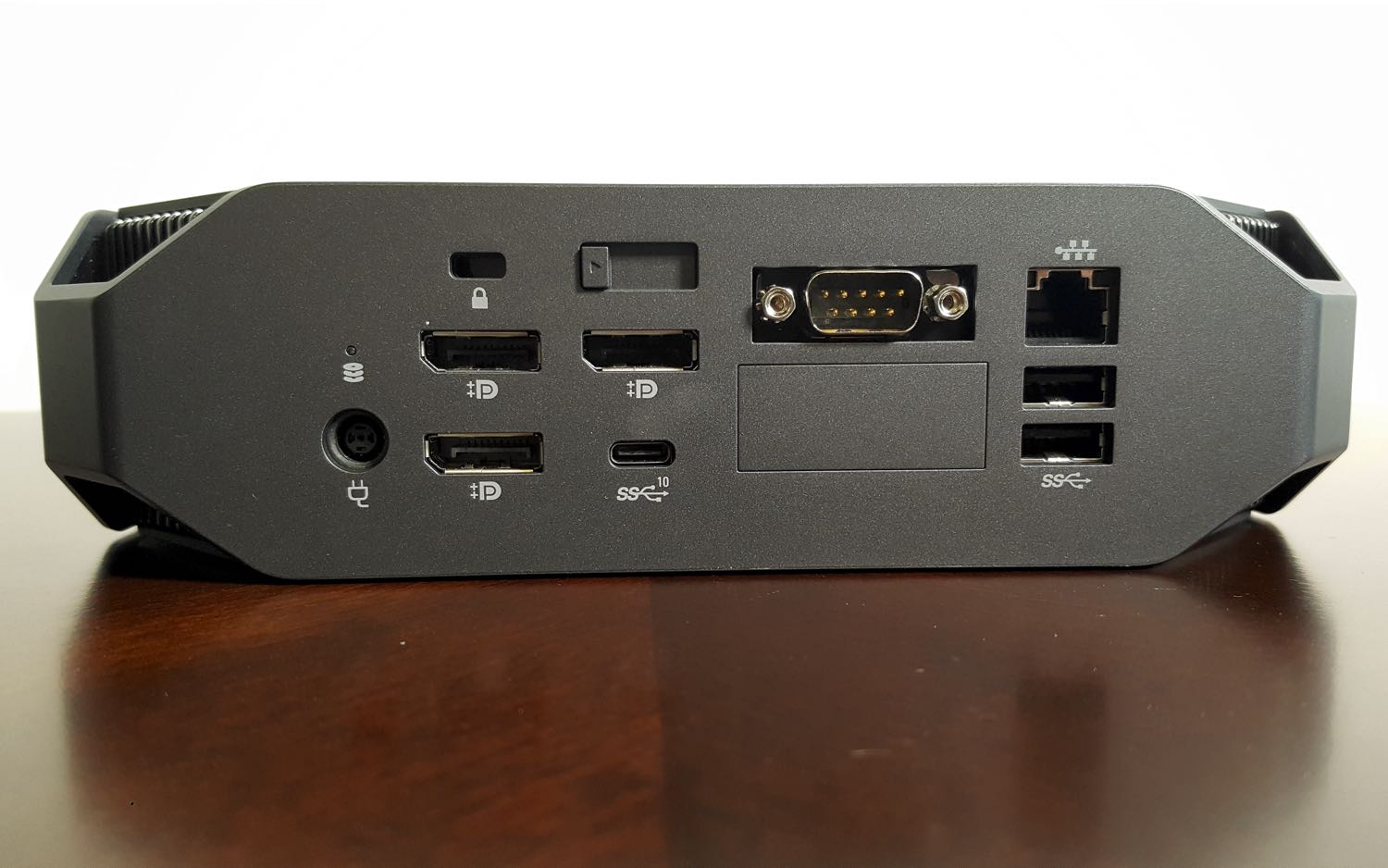
In fact, with two configurable slots, you can get the Z2 Mini G4 outfitted with a variety of connectors: VGA or HDMI output, a fourth DisplayPort, a Thunderbolt 3.0 port or an additional USB-C 3.1 Gen2 port, or even a second Gigabit LAN connection. (And looking forward, HP tells me they plan to offer a 1 gigabit fiber NIC option sometime this year.)
MORE: Best Gaming PCs - Desktop Computers (Including Sub-$1,000
For wireless connectivity, the Z2 Mini G4 is outfitted with 802.11ac WLAN and Bluetooth 5.0.
Performance
Our review unit is one of the better-equipped models offered by HP, armed with a beefy 6-core Intel Xeon E-2176G processor, 32GB of memory, Nvidia Quadro P1000 ISV-certified graphics, and a combination of storage solutions, with a 1TB 7200 rpm HDD and a 256GB HP Z Turbo Drive SSD.
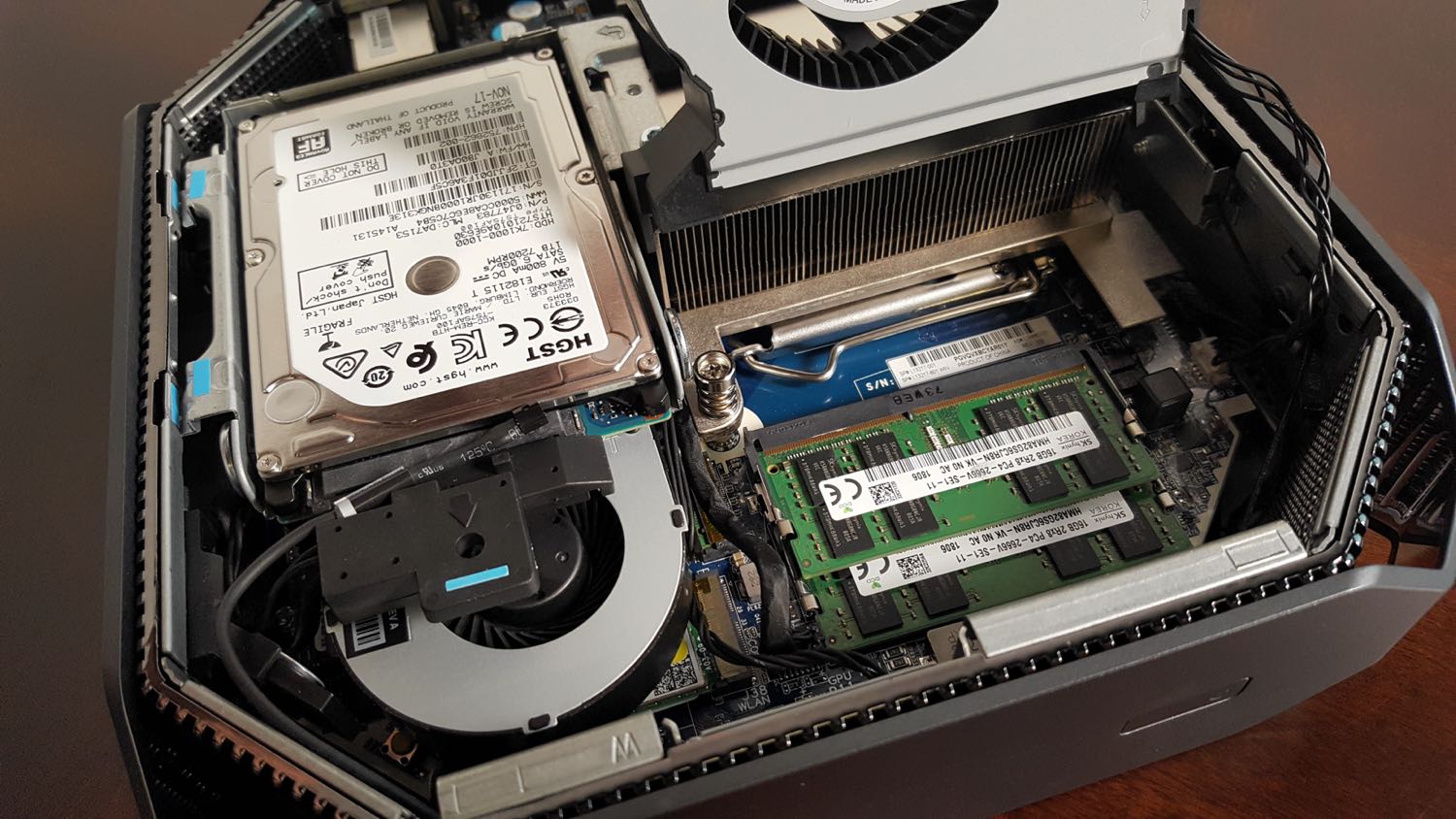
The result is a potent little machine that's geared up for programs like AutoCAD and Solidworks. Our informal test of browsing with multiple browser tabs open was barely a blip on the radar; the Z2 Mini didn't even break a sweat while switching between 20 open tabs and streaming 4K video, and, honestly, that's what we expect from a workstation machine like this. In most of our tests, the Z2 Mini G4 posted not just impressive results, but category-leading performances.
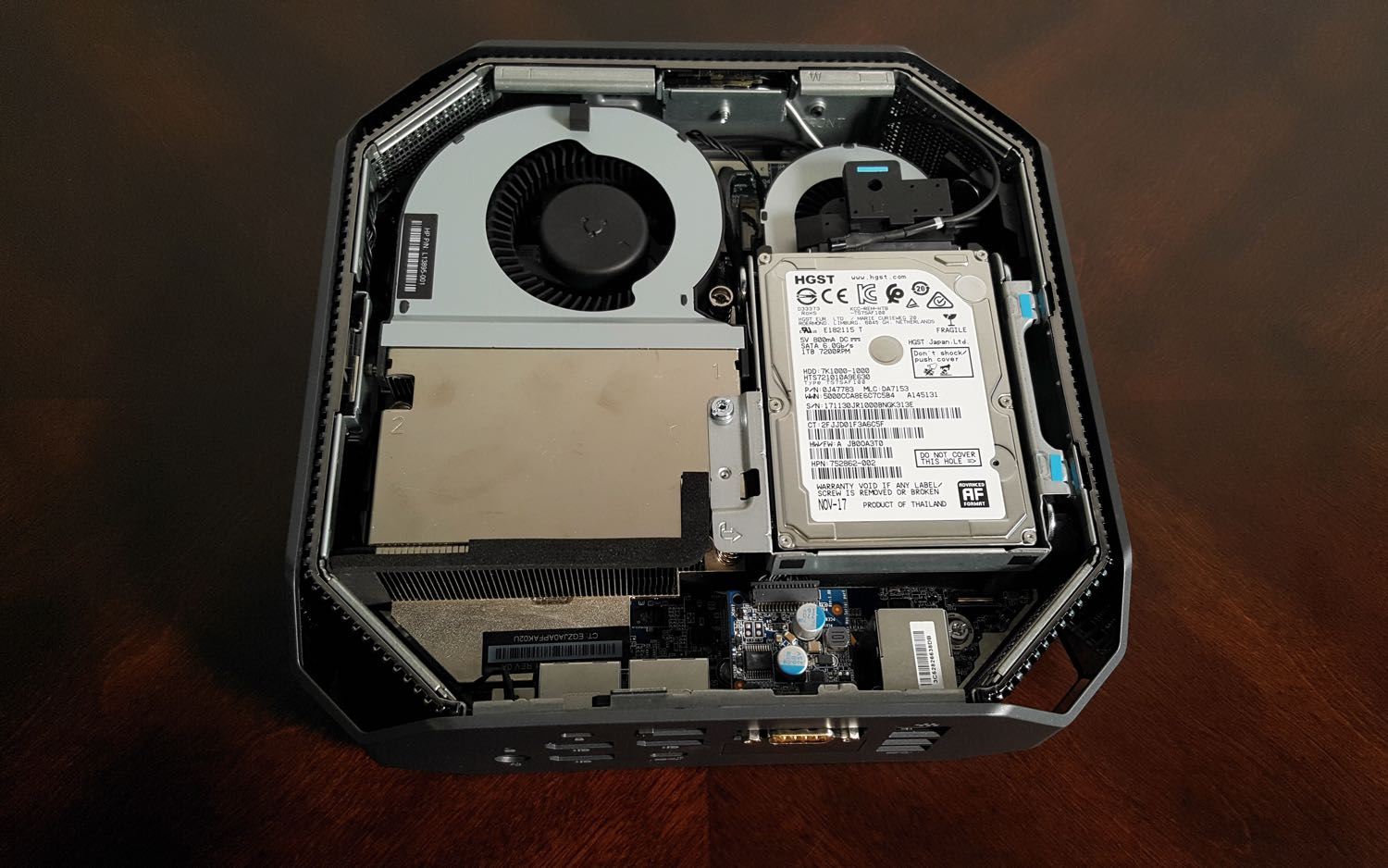
File-transfer speeds were blazing fast, copying our 4.97GB test folder in 5 seconds flat, which works out to 1,017.8 MBps. That’s more than three times as fast as the Intel Hades Canyon NUC (310.60 MBps), and exponentially faster than the 2017-model HP Z2 Mini G3 (101 MBps) or the Lenovo ThinkCentre M710q Tiny (169 MBps).
In the Geekbench 4.0 performance test, the Z2 Mini G4 scored 22,314 points, easily outpacing the 2017 Z2 Mini G3 (15,287 points, with an Intel Core i7-6700 and 32GB of RAM), and leaving basic office desktops in the dust, like the Lenovo ThinkCentre M710q Tiny (8,010, with Intel Core i5-7500T and 8GB RAM).
In most of our tests, the Z2 Mini G4 posted not just impressive results, but category-leading performance.
Even in the newer Geekbench 4.1 test, it led the pack, scoring 23,921 points compared with the Intel Hades Canyon NUC (17,683, with an Intel Core i7-8809G and 16GB RAM) and the Lenovo ThinkCentre M710q Tiny (10,585).
Pure processing power is also hard to top, thanks to the hex-core Xeon CPU inside. It finished our single-thread OpenOffice spreadsheet test quickly, matching 20,000 names and addresses in 2 minutes and 45 seconds. Last year's Z2 Mini G3 completed the same test in 3:30, and the Lenovo ThinkCentre M710q Tiny took 3:52 to complete the same task.
MORE: Laptops with the Best Overall Performance
In our updated version of the test, which uses Excel instead of OpenOffice to test multithread processing, the Z2 Mini G4 was even faster, ripping through the task in 34 seconds. The Lenovo ThinkCentre M710q Tiny finished the same Excel test in 1:21.
Graphics
The graphics performance of any workstation takes on added importance given that workstations are used for all sorts of visual- and rendering-heavy tasks that can have real world implications. Animating a 3D character takes serious horsepower, but designing a bridge adds a heightened expectation that everything is done right. Suffice it to say, graphics performance is a must for anything calling itself a workstation.
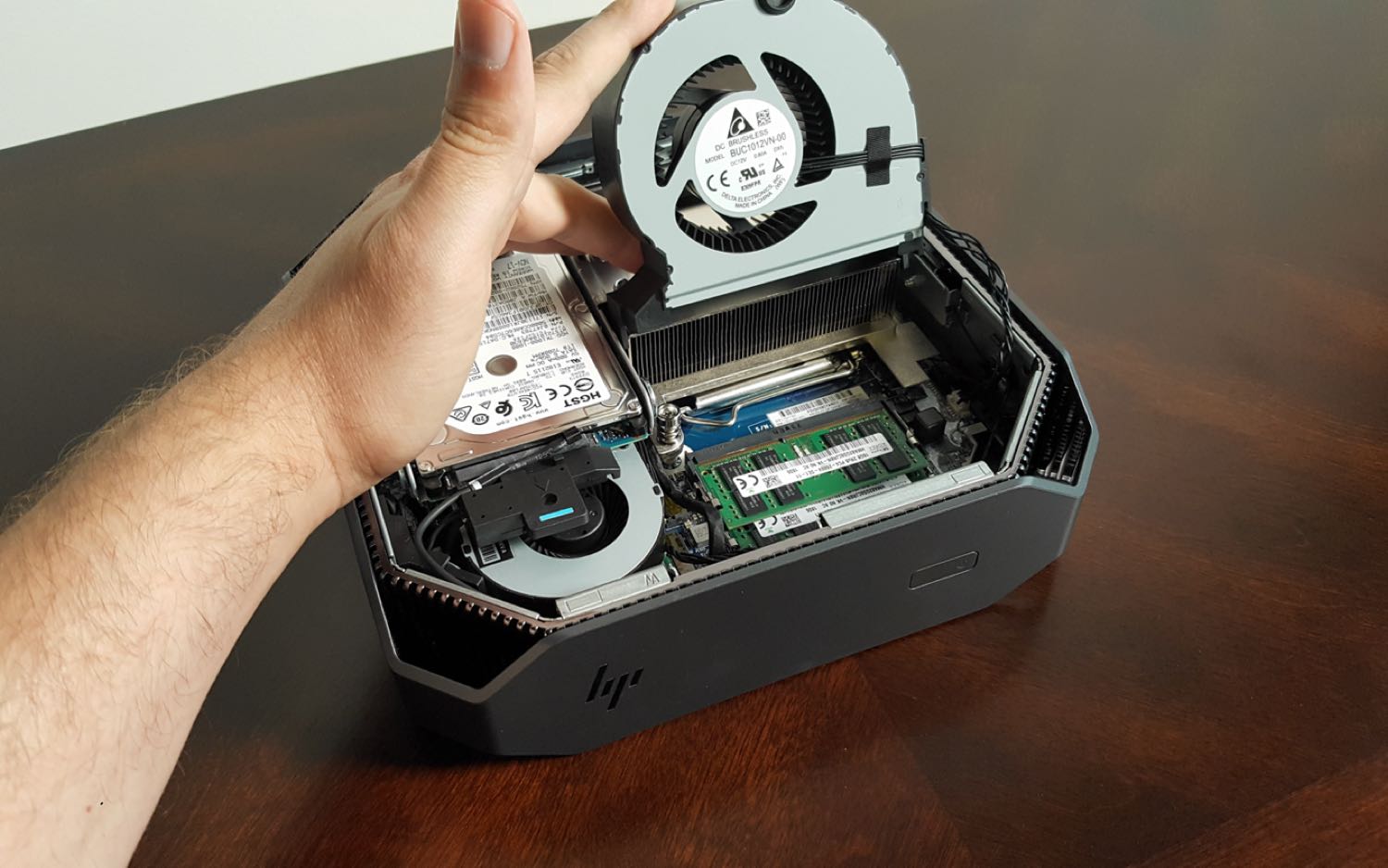
For a baseline of performance, we use 3DMark Pro, running two separate benchmarks, Ice Storm Unlimited, which is built to run on everything from powerful gaming rigs to low-powered tablets and smartphones. The Z2 Mini G4 scored 170,676 points, edging ahead of the Intel Hades Canyon NUC (169,443) but showing the leap in capability since last-year's Z2 Mini G3 (126,890). To put this in perspective, the Lenovo ThinkCentre M710q Tiny scored only 69,398 with its integrated graphics, which is more than adequate for standard office work.
We also ran the more intensive 3DMark Fire Strike, where the Z2 Mini G4 scored a decent 4,609 points. That's a big step up from last year's model (3,019), but it does fall slightly behind the gaming-oriented Intel Hades Canyon NUC (8,451), which features Radeon RX Vega M graphics.
Gaming performance also gives us an idea of the graphics capability the Z2 Mini G4 offers. In Dirt 3, the workstation averaged 166 frames per second (fps) at 1080p, and still delivered strong frame rates (51 fps) at 4K resolution. That's higher than last year's Z2 Mini G3, which was already a strong performer with 104 fps at 1080p and 30fps at 4K. Compare this to the Lenovo ThinkCentre M710q Tiny, which failed to hit the playability threshold of 30 fps, producing 22 fps at 1080p and 14 fps at 4K resolution.
MORE: Best Graphics Performance
But while the Z2 Mini G4's strong graphics capability is a boon to engineers and architects who want a smaller PC on their desk, it's not quite enough for those who want to create in virtual reality. When we tried running the SteamVR performance test, it advised us to get an upgrade, saying that the system's Nvidia Quadro P1000 wasn't well-suited to rendering demands of VR.
Heat
Thermal management is always a concern on these pint-size PCs, since the small confines of the chassis don’t leave much room for cooling fans and air circulation, and you don’t want your little computer to be a fire hazard.
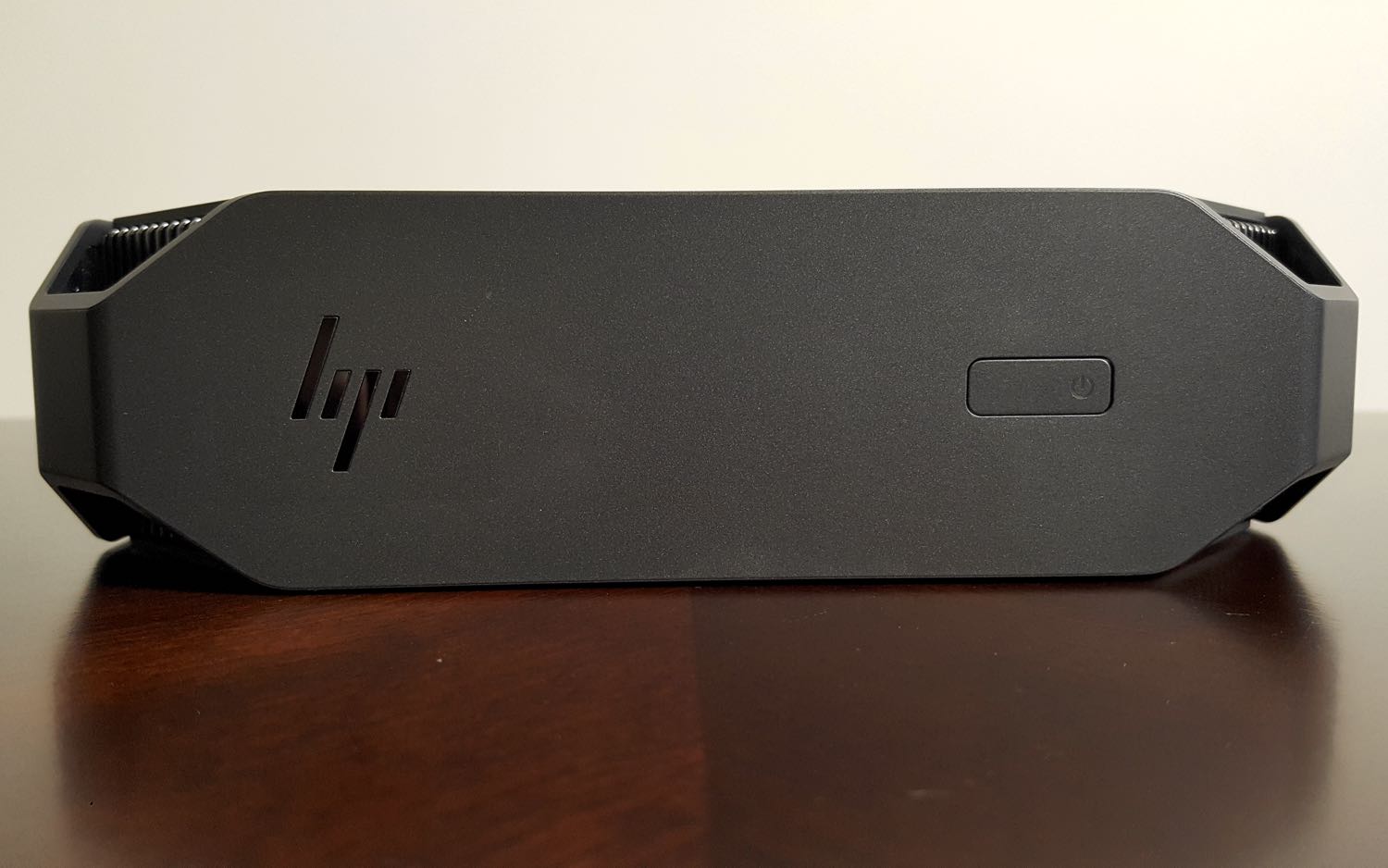
Thankfully, the Z2 Mini G4 kept things relatively cool, with external temperatures reaching 94 degrees Fahrenheit on the top panel of the chassis and 100 degrees on the underside. While that's a bit warmer than the 95-degree comfort threshold we apply to laptop PCs, it's not bad for a desktop. A lot of that is due to the design, which puts ventilation grilles at each of the four corners of the chassis.
We love almost everything about the Z2 Mini, but it does get loud.
But cool doesn't mean quiet. Even running a basic benchmark test kicked the fans into high gear, and the Z2 Mini starts sounding like a small vacuum cleaner whenever the processing hardware is running hot. We love almost everything about the Z2 Mini, but it does get loud.
Software and Warranty
The Z2 Mini G4 can be set up with either Windows or Linux, and our review unit came with Windows 10 Pro (64-bit) preinstalled. Microsoft includes some decidedly nonprofessional software with the Pro version of its OS, like Candy Crush Soda Saga and Minecraft: Windows 10 Edition, but these can be ignored or removed.
Of more importance to the professional crowd are the Z2 Mini's independent software vendor (ISV) certifications, where HP has partnered with individual software companies to ensure that mission-critical programs and apps are completely compatible with the workstation hardware. This certification goes beyond simply ensuring the program will run, and includes stability testing and certification that the programs will run error-free.
MORE: Best Mini PC - Small Computers for Work, Gaming
If you're using the workstation to design products that need to be safe, or to run analyses for multimillion-dollar businesses, you need it to run properly every time, and that’s the peace of mind offered by ISV certifications. The Z2 Mini G4 is certified for several programs from Autodesk (AutoCAD, Revit, Inventor, Maya and more), Adobe, Solidworks and Siemens (including SolidEdge and Tecnomatix).
HP also includes several built-in security tools, which protect the system from the BIOS to the browser, and are part of HP's top-of-the-line enterprise offerings. This includes Sure Start, which protects the BIOS and is self-healing in the event of an attack; Sure Run, which monitors essential processes – including AV and firewalls – for corruption and will actually restart the OS to protect it if an attack is detected; Sure Click, which offers secure browsing that isolates potential malware and individual tabs to prevent exploits; and a full manageability kit for IT departments.
HP covers the Z2 Mini G4 with a three-year warranty that includes three years of coverage on parts and labor and offers three years of on-site repair.
Configurations
The Z2 Mini G4 comes in a wide range of configurations, starting as low as $799. Our review unit, on the other hand, came with some of the best configuration options available, and sells for $2,149, but it comes with powerful components: An intel Xeon E-2176G CPU, 32GB of RAM, Nvidia Quadro P1000 GPU and a dual-drive setup with a 1TB HDD and 256GB SSD.
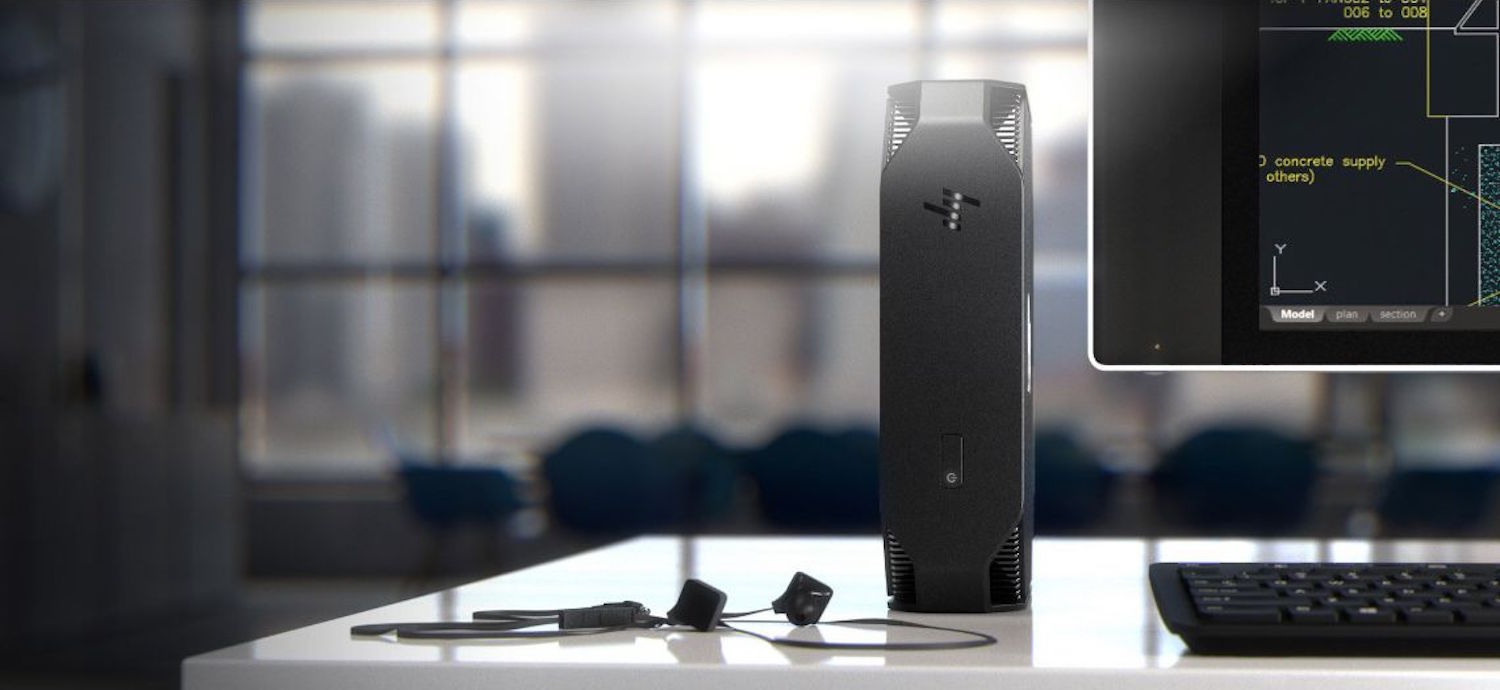
Between those two extremes are plenty of options. For processing, you've got everything from standard Intel Core i3 and Core i5 8000-series processors, along with 4- and 6-core Core i7 and Xeon E 2100-series processors. Two SO-DIMM slots can be filled with as little as 4GB RAM to up to 32GB of memory, with DDR4-2667 and ECC memory support.
For storage, you've got one M.2 slot and a 2.5-inch bay for a SATA drives. All together you can cram up to 3 terabytes (2TB 5400rpm HDD and a 1TB HP Z Turbo SSD) into the Z2 Mini's tiny chassis. On top of this, you can customize the port selection using the Flex I/O options mentioned above, adding video outputs, LAN ports and more.
Finally, there are plenty of graphics options. If you need sheer processing power without heavy rendering demands, you can opt for integrated Intel UHD Graphics 630. If you want ISV-certified graphics for CAD and similar uses, you've got a selection of dedicated GPUs – Nvidia Quadro P600 or P1000 cards, or an AMD Radeon Pro WX 4150.
Bottom Line
All in all, the HP Z2 Mini G4 manages to be a potent workstation, a versatile and powerful mini PC and a highly configurable system that can be almost anything you need it to be. The Z2 Mini line was already impressive simply by fitting workstation power into the mini PC form factor. But the Z2 Mini G4 boosts this further with legitimately powerful hardware that doesn't just check the box for workstation capability, it sets a new bar for how much power a mini PC can provide.
If you're looking for workstation power in a smaller-than-small form factor, the Z2 Mini G4 is the way to go. Gamers may have the Intel Hades Canyon NUC, and regular office workers can opt for the Lenovo ThinkCentre M710q Tiny, but for pure power and performance backed with ISV certifications and solid security, the HP Z2 Mini G4 wins hands down.
Credit: Tom's Guide
Brian Westover is currently Lead Analyst, PCs and Hardware at PCMag. Until recently, however, he was Senior Editor at Tom's Guide, where he led the site's TV coverage for several years, reviewing scores of sets and writing about everything from 8K to HDR to HDMI 2.1. He also put his computing knowledge to good use by reviewing many PCs and Mac devices, and also led our router and home networking coverage. Prior to joining Tom's Guide, he wrote for TopTenReviews and PCMag.
